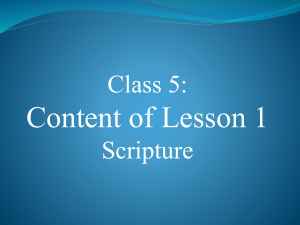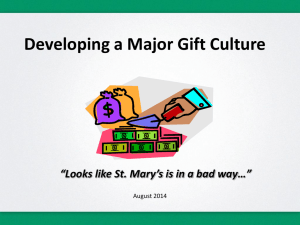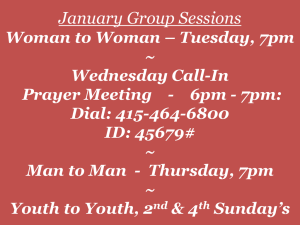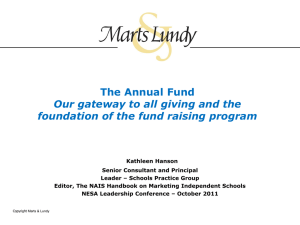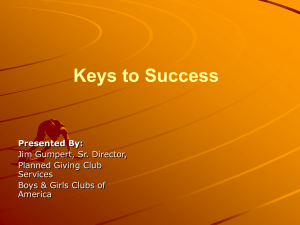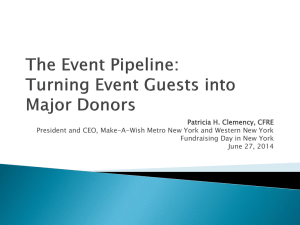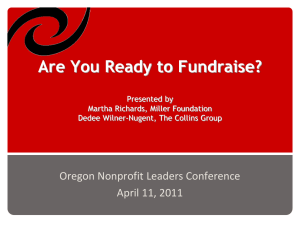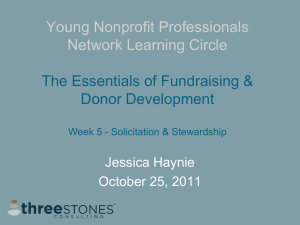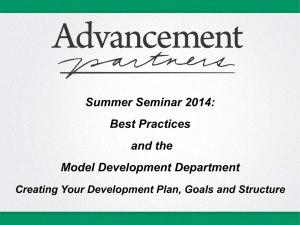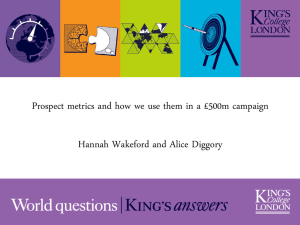Major Gifts Overview
advertisement
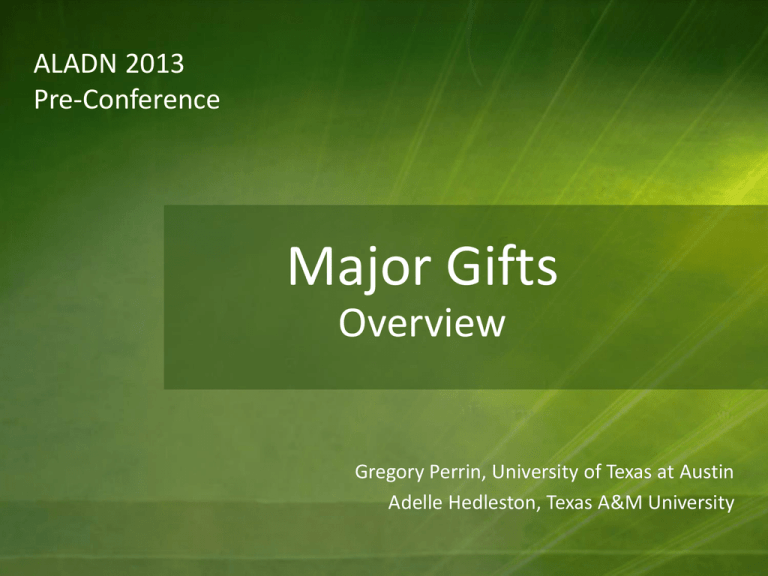
ALADN 2013 Pre-Conference Major Gifts Overview Gregory Perrin, University of Texas at Austin Adelle Hedleston, Texas A&M University Annual Gifts versus Major Gifts VS Annual Gifts • Level of giving - $1 to $24,999 • Frequent gift that helps sustain institution on an annual basis • Unrestricted • Solicited by direct mail, e-mail, phone calls or in person • Builds a base of steady support that may result in a major gift in the future. Major Gifts • • • • Given for designated project Level of giving is $25,000 or more Occur infrequently Solicited in person usually with a proposal or gift agreement • Are about relationships • Longer cultivation period • Part of a planned/estate gift or a current gift Major gifts involve… • • • • • Relationships and trust Longer cultivation period Donor engagement Awareness of projects and programs Asking – you won’t get them if you don’t ask Types of Major Gifts • • • • • • Endowments (Collections, programs or projects) Bequests/Planned Gifts Collections (Appraised In Kind gifts) Scholarships Chairs/Directorships/Professorships Facilities How to Identify a Major Gift Prospect How to Identify a Major Prospect QUALIFY 1. What’s the donors capacity for giving? – Income – Family wealth – will they be inheriting wealth? – Holdings and assets – Where do they live? How many houses or property do they own? Where is it located? How to Identify a Major Prospect 2. Identify a donor’s proclivity or tendency to give – Are they involved in the community? – Do they give to other charities? • Do the charities they support have similar goals and visions as your institution? • And are they making major gifts to these charities? – Have they given to your institution before? » If so, what college, unit or department? » How big was their gift? How to Identify a Major Prospect 3. Utilize your board members – Wealthy people know other wealthy and connected people. Have your board member invite their friends and colleagues to library events, etc. – Use your board members to get introduced to people you normally wouldn’t have the opportunity to meet on your own. Build relationships with people they know. How to Identify a Major Prospect 4. Analyze current donors – Are they consistent givers? – Have they given 5 years or more? 5. Ask central development or foundation research unit for help in generating a list. Who are your potential major donors? • Your current donors – Consistent donors – 5 years of more • • • • Retired faculty and staff Alumni who worked in the library Alumni who received graduate degrees Your board members (Friends board, Advisory Council, Development Council) • Friends of the Library groups Cultivation Every letter, brochure, phone call, conversation and event forms an impression on a donor. Make your message impressive and consistent. What is Cultivation? • Relationship-building that leads to giving • You learn about donors and they learn about your institution • May take 2 – 5 years…or more • Define the most important things you want your donors to know about your mission • Find out your donor’s passion. People are more invested if they are give to something that they are passionate about. Cultivation • Focus on key issues to create awareness among your donors • Use your boards to be ambassadors for your library, but make sure their message is your message. Process for Making the Ask Process for Making the Ask • You can NEVER prepare too much. • Is the donor at the appropriate stage of cultivation to be asked? • Are they interested in giving to your library? • What is their capacity? • What would they like to accomplish with their money that is meaningful to them? • Who will make the ask? • Who needs to be present? Process for Making the Ask • • • • Prep your dean, director or department head Avoid asking over a meal Be prepared to respond to Yes, No or Maybe. Factor in multi-year giving, blended gifts, and planned gifts Process for Making the Ask • • • • • Have follow up plan outlined before asking Asking is a conversation…not a transaction After you have asked them…..LISTEN! Thank them no matter what the response Follow up Stewardship…more than a thank you • • • • • • • • Doesn’t end after gift is received Stay in touch – communicate often Use the gift how the donor designates Continue saying “thank you” Expand the relationship Acknowledge and recognize gift and donor Report on the impact of the gift Opportunity to cultivate for future gift How to Turn Annual Giving into Major Gifts • Stewardship • Continued cultivation • Realizing a gift is the beginning of a relationship not the end. • Leverage special collections • Ask Things to remember • Cultivate – donors make their giving decision on how well they know and trust your organization. • Solicitation - know what you are asking for, then make sure the donor knows. • Stewardship – can lead to future gifts. Questions?
